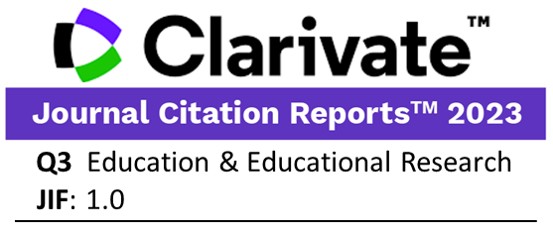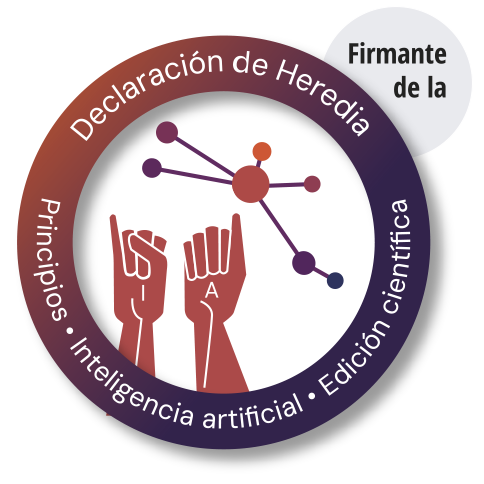Didácticas docentes para el pensamiento crítico en ambientes virtuales
DOI:
https://doi.org/10.24320/redie.2024.26.e21.5419Palabras clave:
pensamiento crítico, estrategias educativas, formación docente, didácticas docentesResumen
Este trabajo tiene como objetivo identificar los elementos presentes en las didácticas docentes para la generación de pensamiento crítico en ambientes virtuales. Utilizando una metodología de corte cualitativo se analiza la forma en que las didácticas del aula centradas en la dialogicidad afectan la transición de una educación presencial contemplativa a una virtual participativa, generadora de pensamiento crítico y corresponsable del proceso formativo. Las comunidades mixtas de investigación del apartado metodológico permiten correlacionar la manera en que discentes y docentes se reflejan en un espacio informacional, discursivo y formativo, lo que sirve de base para la descripción de los cambios vividos a raíz de la pandemia de COVID-19 en las prácticas dialógicas. Los resultados muestran que las didácticas docentes se han modificado, abriendo una brecha que afecta los espacios de diálogo en clase.
Descargas
Referencias
Aguirre-Mejía, E. T. y Canibe-Cruz, F. (2020). Análisis de competencias clave, como factores para transferencia del conocimiento. Investigación Administrativa, 49(126), 12605. https://www.iadministrativa.escasto.ipn.mx/index.php/IA/article/view/39
Alexander, P. (2014). Thinking critically and analytically about critical-analytic thinking: An introduction. Educational Psychology Review, 26, 469–476. https://doi.org/10.1007/s10648-014-9283-1
Anijovich, R. (2019). Orientaciones para la formación docente y el trabajo en el aula: Retroalimentación formativa. Summa.
Basile, G. (2020). SARS-CoV-2 en América Latina y Caribe: las tres encrucijadas para el pensamiento crítico en salud. Ciência & Saúde Coletiva, 25(9), 3557–3562. https://doi.org/10.1590/1413-81232020259.20952020
Buckley, J., Archibald, T., Hargraves, M. y Trochim, W. M. (2015). Defining and teaching evaluative thinking: Insights from research on critical thinking. American Journal of Evaluation, 36(3), 375–388. https://doi.org/10.1177/1098214015581706
Carabelli, P. (2020). Respuesta al brote de COVID-19: tiempo de enseñanza virtual. InterCambios. Dilemas y transiciones de la Educación Superior, 7(2), 167–173. https://ojs.intercambios.cse.udelar.edu.uy/index.php/ic/article/view/257
Carson, S., (2015) Targeting critical thinking skills in a first-year undergraduate research course. Journal of Microbiology and Biology Education, 16(2), 148–156. https://doi.org/10.1128/jmbe.v16i2.935
Cejas-León, R. y Navío-Gámez, A. (2020). Sobre la formación tecnopedagógica del profesorado. La visión de los expertos y formadores. Revista Iberoamericana de Educación Superior, 11(31),150–164. https://doi.org/10.22201/iisue.20072872e.2020.31.711
Correa, C. (2013). Monolinguism of other as a limit of a narrative identity. retelling the university today. Mediterranean Journal of Social Sciences, 4(9), 682–688. https://doi.org/10.5901/mjss.2013.v4n9p682
Cortés, J. L. (2021). El estrés docente en tiempos de pandemia. Revista Dilemas contemporáneos: educación, política y valores, 8(1). https://www.scielo.org.mx/scielo.php?script=sci_arttext&pid=S2007-78902021000300006
Delgado, U. y Martínez, F. G. (2021). Entornos virtuales de aprendizaje adoptados en la universidad ante el COVID -19. Diálogos sobre Educación, 12(22), 1–14. http://dialogossobreeducacion.cucsh.udg.mx/index.php/DSE/article/view/829
Feixas, M., Fernández, A., Lagos, P., Quesada, C. y Sabaté, S. (2014). Factores condicionantes de la transferencia de la formación docente en la universidad: un estudio sobre la transferencia de las competencias docentes. Journal for the Study of Education and Development, 36(3), 401–416. https://doi.org/10.1174/021037013807533034
García-Gutiérrez, J. y Ruiz-Corbella, M. (2020). Aprendizaje-servicio y tecnologías digitales: un desafío para los espacios virtuales de aprendizaje. Revista Iberoamericana de Educación a Distancia, 23(1), 31–42. https://doi.org/10.5944/ried.23.1.25390
Halpern, D. F. (2014). Thought and knowledge: An introduction to critical thinking. Psychology Press.
Hernández, R. M. (2017). Impacto de las TIC en la educación: retos y perspectivas. Propósitos y Representaciones, 5(1), 325–347. http://dx.doi.org/10.20511/pyr2017.v5n1.149
Latorre-Cosculluela, C., Vázquez-Toledo, S., Rodríguez-Martínez, A. y Liesa-Orús, M. (2020). Design Thinking: creatividad y pensamiento crítico en la universidad. Revista Electrónica de Investigación Educativa, 22, e28. 1–13. https://doi.org/10.24320/redie.2020.22.e28.2917
Maroscia, C. y Ruiz, P. (2021). Las organizaciones de la sociedad civil en época de pandemia. Reflexiones hacia una nueva normalidad: ¿nuevos desafíos o mismas realidades? Ciencias Administrativas, (17), 97–107. https://dx.doi.org/https://doi.org/10.24215/23143738e079
Miguel, J. A. (2020). La educación superior en tiempos de pandemia: una visión desde dentro del proceso formativo. Revista Latinoamericana de Estudios Educativos, 50(Esp.),13–40. https://doi.org/10.48102/rlee.2020.50.ESPECIAL.95
Moen, T. (2006). Reflections on the narrative research approach. International Journal of Qualitative Methods, 5(4), 56–69. https://doi.org/10.1177/160940690600500405
Mok, F. y Yuen T. (2016). A critical evaluation of the understanding of critical thinking by school teachers: The case of Hong Kong. Citizenship, Social and Economic Education, 15(1), 28–44. https://doi.org/10.1177/2047173416652146
Moore, T. (2013). Critical thinking: Seven definitions in search of a concept. Studies in Higher Education, 38(4), 506–522. https://doi.org/10.1080/03075079.2011.586995
Mosely, G., Wright, N. y Wrigley, C. (2018). Facilitating Design Thinking: a comparison of design expertise. Thinking Skills and Creativity, 27, 177–189. https://doi.org/10.1016/j.tsc.2018.02.004
Nafukho, F. M., Alfred, M., Chakraborty, M., Johnson, M. y Cherrstrom, C. A. (2017). Predicting workplace transfer of learning: A study of adult learners enrolled in a continuing professional education training program. European Journal of Training and Development, 41(4), 327–353. http://doi.org/10.1108/EJTD-10-2016-0079
Novoa-Castillo, P., Uribe-Hernández, Y., Garro-Aburto, L. y Cancino-Verde, R. (2021). Estrategias metacognitivas en entornos digitales para estudiantes con baja comprensión lectora. Revista Electrónica de Investigación Educativa, 23, e28, 1–34. https://doi.org/10.24320/redie.2021.23.e28.3953
Ooiwa, A. (2012). Implications of EFL critical pedagogy: Theory, practice and possibility. https://www.keiwa-c.ac.jp/wp-content/uploads/2012/12/kiyo21-3.pdf
Pérez-Zúñiga, R., Mena-Hernández, E. y Pereida-Alfaro, M. A. (2019). Las tecnologías de la información y comunicación como soporte flexibilizador en el proceso enseñanza-aprendizaje. Revista de Educación y Desarrollo, 50, 59–72. https://www.cucs.udg.mx/revistas/edu_desarrollo/anteriores/50/50_PerezZuniga.pdf
Perines, H. A. (2020). La formación en investigación educativa de los futuros profesores. Formación universitaria, 13(4), 139–152. https://dx.doi.org/10.4067/S0718-50062020000400139
Persky, A. M., Medina, M. S. y Castleberry, A. N. (2019). Developing critical thinking skills in pharmacy students. American Journal of Pharmaceutical Education, 83(2). https://www.ncbi.nlm.nih.gov/pmc/articles/PMC6448513/
Radu, M. C. Schnakovszky, C. Herghelegiu, E. Ciubotariu, V. A. y Cristea, I. (2020). The impact of the COVID-19 pandemic on the quality of educational process: A student survey. International Journal of Environmental Research and Public Health, 17(21), 1–15. https://doi.org/10.3390/ijerph17217770
Riascos, B. N. y Benavides, P. O. (2021). Del umbral de las escuelas al dintel de la incertidumbre. El umbral de la escuela como espacio de enseñanza y el aprendizaje. Diálogos sobre Educación, 12(22), 1–23. http://dialogossobreeducacion.cucsh.udg.mx/index.php/DSE/article/view/889
Robinson, S. R. (2011). Teaching logic and teaching critical thinking: Revisiting McPeck. Higher Education Research & Development, 30(3), 275–287. https://doi.org/10.1080/07294360.2010.500656
Rodríguez, A. M. y Chávez, E. I. (2020). Cibernética educativa, actores y contextos en los sistemas de educación superior a distancia. Sophia-Colección de Filosofía de la Educación, 23(28), 129–148. https://doi.org/10.17163/soph.n28.2020.04
Shell, M. (2019). The power of narrative: A practical guide to creating decolonial, community-based projects. En B. M. Nchindila y T. Corrigan (Eds), The essence of academic performance. https://www.intechopen.com/books/7906
Tamayo, O. E., Zona, R. y Loaiza, Y. E. (2015). El pensamiento crítico en la educación. Algunas categorías centrales en su estudio. Revista Latinoamericana de Estudios Educativos, 11(2), 111–133. http://vip.ucaldas.edu.co/latinoamericana/downloads/Latinoamericana11(2)_6.pdf
Vendrell, M. y Rodríguez, J. M. (2020). Pensamiento crítico: conceptualización y relevancia en el seno de la educación superior. Revista de la Educación Superior, 49(194), 9–25. http://resu.anuies.mx/ojs/index.php/resu/article/view/1121
Wenger, E. (1998). Communities of practice: Learning, meaning, and identity. Cambridge University Press.
Wong, B., Ying, B. y O´Brien, B. (2016). Neurolingüistics: Structure, function, and conectivity in the bilingual brain. Biomedic Research International, 9 (Special), 1–22. https://doi.org/10.1155/2016/7069274
Yavorski, R. y Campos, M. (2019). Formación docente: la formación del profesor y la influencia sobre el aprendizaje de los alumnos. MLS-Educational Research, 3(1), 25–42. https://doi.org/10.29314/mlser.v3i1.70
Descargas
-
HTML
-
PDF
-
XML
-
EPUB
-
AUDIO RESUMENESPAÑOL 165
Visitas a la página del resumen del artículo: 1842
Publicado
2025-01-31Licencia
Derechos de autor 2025 Guillermo Isaac González-Rodríguez, Maira Beatriz García-Híjar

Esta obra está bajo una licencia internacional Creative Commons Atribución-NoComercial 4.0.















